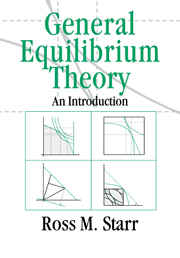Book contents
- Frontmatter
- Contents
- List of illustrations
- Foreword
- Preface
- Table of notation
- A Getting started
- B An economy with bounded production technology, supply and demand functions
- C An economy with unbounded production technology, supply and demand functions
- D Welfare economics
- E Bargaining and equilibrium: The core
- 13 The core of a market economy
- 14 Convergence of the core of a large economy
- F The scope of markets
- G An economy with supply and demand correspondences
- H Conclusion
- Bibliography
- Index
14 - Convergence of the core of a large economy
Published online by Cambridge University Press: 05 June 2012
- Frontmatter
- Contents
- List of illustrations
- Foreword
- Preface
- Table of notation
- A Getting started
- B An economy with bounded production technology, supply and demand functions
- C An economy with unbounded production technology, supply and demand functions
- D Welfare economics
- E Bargaining and equilibrium: The core
- 13 The core of a market economy
- 14 Convergence of the core of a large economy
- F The scope of markets
- G An economy with supply and demand correspondences
- H Conclusion
- Bibliography
- Index
Summary
Replication; a large economy
There is a long-standing tradition in economic theory emphasizing the importance of large (“thick”) markets in maintaining competition. The underlying idea is that if the number of agents in the market is large enough then no single agent can have monopoly power. Consequently, a competitive price-taking equilibrium will be maintained. Our task in this chapter is to present a rigorous statement and proof of this result in the model of the core of a market economy. We will show that in a large economy, the core allocations are nearly identical to the competitive equilibrium allocation. That is, in a large economy, there is virtually no incremental return to the monopolistic strategic behavior associated with coalition formation (the strategic behavior assumed in the core). Hence in a large economy, there is no point in behaving strategically. The best an agent can do is to follow pricetaking competitive behavior. This result is actually quite general in models where no single trader is large relative to the size of the market. The version of the theorem we will present here depends on the idealization that the economy becomes large (and hence each trader becomes strategically negligible) through successive replication of the set of traders. The economy keeps cloning itself. As the growth goes from duplicate to triplicate, …, to Q-tuplicate, and so on, the set of core allocations keeps getting smaller, although it always includes the set of competitive equilibria (per Theorem 13.1). We will show that it eventually shrinks to the point where only the competitive equilibria are left. This is the core convergence result.
- Type
- Chapter
- Information
- General Equilibrium TheoryAn Introduction, pp. 162 - 174Publisher: Cambridge University PressPrint publication year: 1997



